 Vicki found that she needed to patch jeans not long after Mike’s local truck driving company decided to no longer provide company uniforms but rather require their drivers to wear their own pants with company-branded t-shirts.
Vicki found that she needed to patch jeans not long after Mike’s local truck driving company decided to no longer provide company uniforms but rather require their drivers to wear their own pants with company-branded t-shirts.
Patching jeans isn’t hard (depending on the mending that needs to be done).
There may be a variety of ways to do it.
On this page, we describe the way that Vicki developed that worked best for her with one particular mending job.
Location, Location, Location
The way you patch jeans may depend upon where the hole is.
Because Mike hauled flatbed trailers and occasionally had to get up on trailers to tarp loads, he occasionally ripped a hole right in the seat of his pants.
Sometimes, he had holes in the legs or even the crotch area as he has to climb up the trailer facing forward.
Just about any single layer rip in denim or blue jean material can be repaired or patched.
However, the location of the rip may make it a bit challenging to sew it.
For the purposes of this page, we are assuming that a trucker’s home support team is going to hand sew the patch in place.
If you don’t have one, you can do it yourself in your truck if you have the right tools.
The most difficult place to patch jeans in our opinion is on a seam.
The next most difficult sewing job is to re-attach a belt loop.
Want to Patch Jeans: Get Out Your Mini Sewing Kit
Here’s a mini sewing kit available through Amazon.com, with which we have an affiliate relationship.
Recall that we recommend on our personal packing list having a mini sewing kit with you on the road (like the one shown here from Amazon.com, with which we have an affiliate relationship).
You’ll never know when it will come in handy.
What should be in it?
At a bare minimum, you need to have
- a needle,
- thread,
- a small pair of scissors,
- a couple of replacement buttons and
- a few safety pins in your mini sewing kit.
Some mini sewing kits have multiple colors of thread and a few other things.
You can buy one already put together or assemble one of your own and store it in an Altoids tin (like these shown on Pinterest).
About the Patch
When we say “patch jeans,” we really mean sewing a patch in place over a hole, not just sewing the hole closed with thread.
Depending on the nature of the hole, all it may need is to be closed up — not truly patched.
Vicki has attempted to sew an actual hole and just leave the thread in place as the patch, but take it from us, that doesn’t last long in the rough and tumble world of a professional truck driver. (At least it didn’t work well for Mike.)
Also, the patch shown here is an “iron on” type of patch.
We anticipate that many professional truck drivers don’t carry either an iron or an inverter powerful enough to heat an iron with them in their trucks.
Before you begin to patch jeans, you will definitely need:
- the pair of jeans needing to be patched (you knew that!);
- a patch (preferably the same type of material and the same shade as the jeans being mended);
- a needle (the size may or may not matter, but a thin one with enough strength to be pushed through jeans material is a must); and
- thread.
It might also help to have a thimble to help push the needle through the thick fabric.
An optional tool that Vicki found useful in mending jeans — and which you will see in at least a few photos below — is an embroidery hoop.
This device holds the material taut until a few preliminary stitches can be put in place.
Note: It is a bit awkward to fit an embroidery hoop over a seam.
The Material to Patch Jeans With
Vicki has used both denim and old sweatpants material to patch jeans.
If at all possible, try to avoid a mismatch of material.
But if all you’ve got is something else, you may have to make it work.
Pre-shrunk material won’t shrink during the laundering process.
A seamstress who is more concerned about fashion and matching the “grain” of the patch with the material being mended may be more careful than Vicki was in selecting patch material.
Please note that she selected denim from an older pair of jeans that were no longer suitable for wearing.
How to Patch Jeans: A Photo Gallery of One Sewing Task
Vicki took photos as she mended one pair of Mike’s blue jeans.
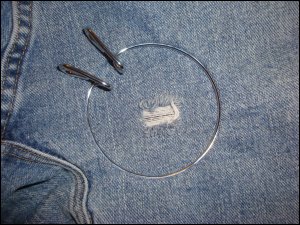 The hole in the jeans that needed patching is being held taut by an embroidery hoop.
The hole in the jeans that needed patching is being held taut by an embroidery hoop.
This was the smallest embroidery hoop Vicki had.
In the past, Vicki has sewn patches on jeans where the hole was so close to a seam that it took a bit of doing to put the hoop in place over the seam.
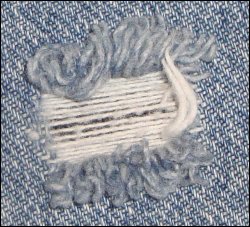 This close-up view of the hole reveals that by the time Vicki got around to mending this pair of jeans, the edges of the hole had become frayed as a result of the laundering process.
This close-up view of the hole reveals that by the time Vicki got around to mending this pair of jeans, the edges of the hole had become frayed as a result of the laundering process.
For the most part, only one set of threads had been eaten away.
We don’t know why.
Some holes are gashes that have no supporting threads at all.
Open gashes require more time and effort to repair.
Gashes with irregular shapes, that tear in two directions (or more) or are large can be a real challenge when you seek to patch jeans.
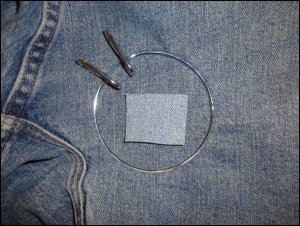 Vicki cut a patch slightly larger than the size of the hole in the jeans.
Vicki cut a patch slightly larger than the size of the hole in the jeans.
If you pick a patch that is too big or too small, you end up wasting your time in the long run.
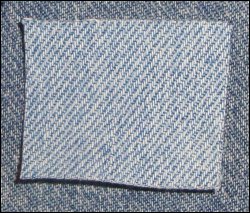 This close up of the patch looks like it fits over the top of the hole without being too big or too small.
This close up of the patch looks like it fits over the top of the hole without being too big or too small.
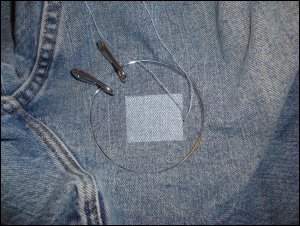 Vicki used the embroidery hoop to hold the jeans material taut so she could sew preliminary stitches.
Vicki used the embroidery hoop to hold the jeans material taut so she could sew preliminary stitches.
In Vicki’s opinion, this is the hardest part of this job.
For every preliminary stitch Vicki put in place, she had to run her hand in and out of the jeans leg.
There’s always a risk of getting stabbed by the needle when one reaches in to pull the needle through without being able to see it.
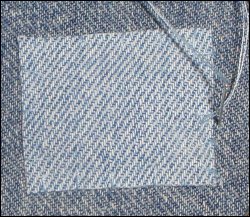 Here’s a close-up view of the preliminary stitches being hand sewn to hold the patch in place.
Here’s a close-up view of the preliminary stitches being hand sewn to hold the patch in place.
Vicki decided that it was best to place preliminary stitches in each corner and in the middle of each side as “anchors.”
If preliminary stitches are not in place first, the patch can go on crooked or cause a pucker or create stress on the fabric.
It’s best to go slowly at first.
Once the preliminary stitches are in place, the embroidery hoop can be removed.
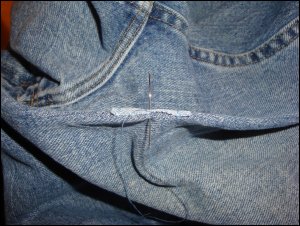 Here, Vicki has folded the jeans along the edge of the patch to sew it on.
Here, Vicki has folded the jeans along the edge of the patch to sew it on.
Once one side has been sewn, the jeans are repositioned for each remaining side to be sewn.
This maneuver allows stitching to take place more easily and more quickly.
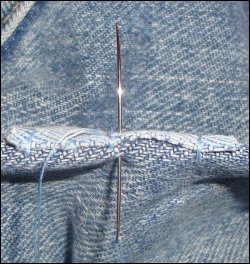 This close-up view of the jeans folded along the edge of the patch shows how easily overcast stitches can be made once the preliminary stitches are in place.
This close-up view of the jeans folded along the edge of the patch shows how easily overcast stitches can be made once the preliminary stitches are in place.
Vicki chose a fairly thin needle for sewing this material.
Had the jeans or the patch been thicker and more difficult to work with, she would have used a thimble to assist with pushing the needle through the fabric.
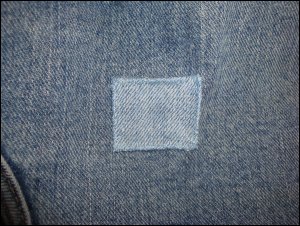 The patch is now completely sewn in place. Hurray!
The patch is now completely sewn in place. Hurray!
Mike was not concerned about
– the color of the patch,
– the color of the thread or
– matching of the twill.
He was simply glad that Vicki extended the life of this pair of jeans.
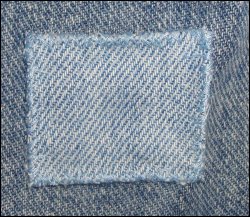 This is a close-up of the patch completely sewn on the jeans.
This is a close-up of the patch completely sewn on the jeans.
See the overcast stitch that Vicki used?
On one pair of jeans, Vicki put a hand-sewn overcast stitch around the edge of the patch before applying it to the jeans.
Since she applied an overcast stitch to sew the patch to the jeans, first overcast stitching the patch by itself was much more work (and probably unneeded).
As you probably know, denim can fray on the edges, so some kind of stitch to prevent fraying is in order.
When Not to Patch Jeans
 If your jeans are really old and threadbare (meaning you’ve gotten your money’s worth out of them), skip the patching and consider replacing them.
If your jeans are really old and threadbare (meaning you’ve gotten your money’s worth out of them), skip the patching and consider replacing them.
Assuming there is anything worth salvaging, take parts of the old jeans and make patches for other newer pairs.
If you like having holes in your jeans as a fashion statement (something we’ve never understood), obviously patching them would be an assault on your “look.”
However, we don’t know of any trucking companies that permit their drivers to wear jeans with holes in them.
You have to ask yourself if jeans with deliberate holes reflect trucking professionalism.
In our opinion, they do not.
![]() Money saving tip: As long as there is wearability in them, it’s a good idea to patch jeans with a hole in them.
Money saving tip: As long as there is wearability in them, it’s a good idea to patch jeans with a hole in them.
Consider how much a new pair of jeans costs.
Mike likes to wear Wrangler relaxed fit jeans, like those shown here.
Vicki tried to find the answer to the question about how long the average pair of jeans lasts.
Mike has a number of pairs.
When he drove regionally (and did a lot of sitting), he could wear jeans for at least a couple of days.
Some trucking jobs require manual labor, such as the strapping and tarping of loads.
When Mike did this, each pair of pants was washed after a single wearing.
With proper laundering of a good quality product, Mike has been able to make his jeans last for years.
If you wear them, we hope you have the same success.
Is there a way to help keep jeans from developing holes?
Everybody knows that in order to make fabric waterproof, you apply a water repellant to it.
But is there a way to help keep jeans from ripping or developing holes and needing to be patched?
We’re not aware of it.
Perhaps you know something we don’t?
Return from How to Patch Jeans: Trucker’s Wife on Patching Jeans With Holes to our Home Support Team page or our Truck Drivers Money Saving Tips home page.









